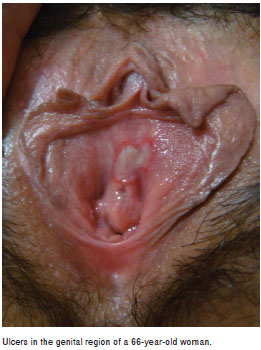Serviços Personalizados
Journal
Artigo
Indicadores
-
 Citado por SciELO
Citado por SciELO -
 Acessos
Acessos
Links relacionados
-
 Citado por Google
Citado por Google -
 Similares em
SciELO
Similares em
SciELO -
 Similares em Google
Similares em Google
Compartilhar
Biomédica
versão impressa ISSN 0120-4157
Biomédica vol.34 no.1 Bogotá jan./mar. 2014
https://doi.org/10.7705/biomedica.v34i1.1729
IMÁGENES EN BIOMEDICINA
doi: http://dx.doi.org/10.7705/biomedica.v34i1.1729
Recibido: 04/09/13; aceptado:24/10/13
A 66-year-old woman presented to our department with a 9-month history of ulcers located in her genital region. She had a two-year history of repeated oral aphthae and erythema nodosum. Use of acyclovir treatment did not lead to good response.
Behcet´s disease is a chronic, relapsing, inflammatory disease characterized by oral aphthae, genital ulcers, non-bacterial folliculitis, uveitis and erythema nodosum. The diagnosis of this condition is based on clinical criteria, as there is as yet no pathognomonic test, and mucocutaneous lesions, which are prominent in the presentation and diagnosis, may be considered the diagnostic hallmarks. Its prevalence varies very much, with higher rates in the so-called "silk route" countries : 80-370/100,000 in Turkey and 30/100,000 in Japan. In contrast, in Europe and the USA, the rate is 0.1-7.5/100,000 (1). Genital ulcers are one of the main components of this complex condition, as they represent the second most common sign after oral aphthae, occurring in 57-93% of cases (1). Genital ulcers are characterized by clear demarcation and great depth. They are painful, they show a scarring tendency and they are usually resistant to local treatments.
The evaluation of any genital ulcers requires consideration of local epidemiology and demography, a careful travel and sexual history, assessment of suggestive clinical features (such as pain, induration and friability) and additional extragenital physical examination; laboratory testing as appropriate, and biopsy for histological study if needed. The differential diagnosis of genital ulcers includes a vast variety of both infectious and non-infectious conditions such as genital herpes, syphilis, chancroid, donovanosis, lymphogranoluma venereum, amebiasis, leishmaniasis, acute vulvar ulcer or Lipschütz ulcer, Crohn´s disease, Behcet´s disease, lichen planus, ulcerated tumors and factitial ulcerations.
Management of genital ulcers in Behcet´s disease is limited, as there are few randomized, controlled trials to guide therapeutic decisions. Topical steroids are the usual therapy. Other therapeutic agents include colchicines, pentoxyphylline, dapsone, thalidomide, azathioprine and interferon (2). Pimecrolimus is an ascomycin macrolactam which recently has been proved to be safe and efficient in the treatment of Behcet´s disease genital ulcers (3). Severe refractory cases have been treated effectively with anti-TNF agents such as etarnecept (4) and adalimumab (5). Our patient was treated with pim ecrolimus 1% cream with satisfactory response. In the follow up, no recurrence has been observed. (figura 1)

The authors have no conflict of interest to declare.
No funding sources.
Corresponding author:
Husein Husein-ElAhmed, Departmento de Dermatología, Hospital Universitario San Cecilio, Avenida Madrid S/N. CP: 18012, Granada, España huseinelahmed@hotmail.com
1. Alpsoy E, Zouboulis CC, Ehrlich GE. Mucocutaneous lesions of Behcet´s disease. Yonsei Med J. 2007;48:573-85. http://dx.doi.org/10.3349/ymj.2007.48.4.573 [ Links ]
2. Keogan MT. Clinical Immunology Review Series: An approach to the patient with recurrent orogenital ulceration, including Behçet´s syndrome. Clin Exp Immunol. 2009;156:1-11. http://dx.doi.org/10.1111/j.1365-2249.2008.03857.x [ Links ]
3. Chams-Davatchi C, Barikbin B, Shahram F, Nadji A, Moghaddassi M, Yousefi M, et al . Pimecrolimus versus placebo in genital aphthous ulcers of Behcet´s disease: A randomized double-blind controlled trial. Int J Rheum Dis. 2010;13:253-8. http://dx.doi.org/10.1111/j.1756-185X. 2010.01531.x [ Links ]
4. Kasugai C, Watanabe D, Mizutani K, Masuda Y, Zako M, Mukai T, et al . Infliximab treatment of severe genital ulcers associated with Behçet disease. J Am Acad Dermatol. 2010;62:162-4. http://dx.doi.org/10.1016/j.jaad.2009.02.044 [ Links ]
5. Olivieri I, D´ Angelo S, Padula A, Leccese P, Mennillo GA. Successful treatment of recalcitrant genital ulcers of Behçet´s disease with adalimumab after failure of infliximab and etanercept. Clin Exp Rheumatol. 2009;27 (2 Suppl 53):S112. [ Links ]













